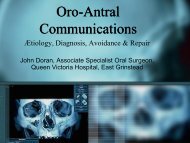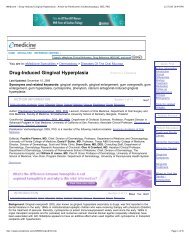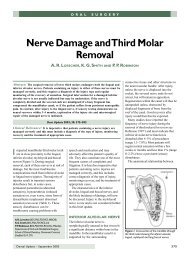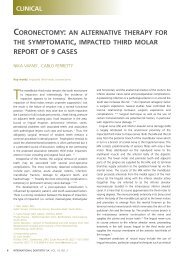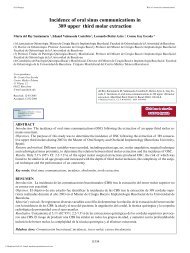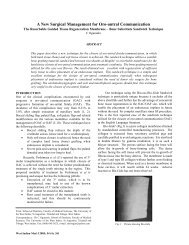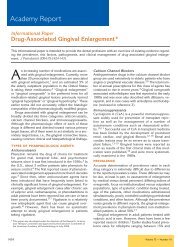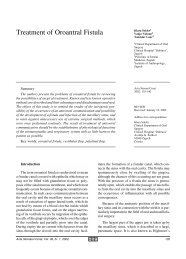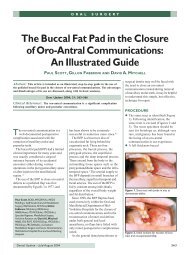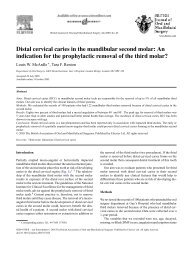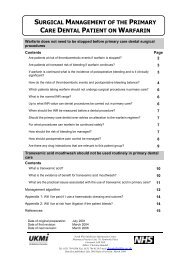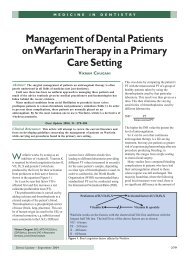Inferior alveolar nerve damage following removal of ... - Exodonti.info
Inferior alveolar nerve damage following removal of ... - Exodonti.info
Inferior alveolar nerve damage following removal of ... - Exodonti.info
You also want an ePaper? Increase the reach of your titles
YUMPU automatically turns print PDFs into web optimized ePapers that Google loves.
Scientific papers<br />
Australian Dental Journal 1997;42:(3):149-52<br />
<strong>Inferior</strong> <strong>alveolar</strong> <strong>nerve</strong> <strong>damage</strong> <strong>following</strong> <strong>removal</strong> <strong>of</strong><br />
mandibular third molar teeth. A prospective study<br />
using panoramic radiography<br />
Andrew C. Smith, BDS, FDSRCS, FDSRCPS, FRACDS(OMS)*<br />
Susan E. Barry, BDSc†<br />
Allan Y. Chiong, BDSc†<br />
Despina Hadzakis, BDSc†<br />
Sung-Lac Kha, BDSc†<br />
Steven C. Mok, BDSc†<br />
Daniel L. Sable, BDSc†<br />
Abstract<br />
Permanent alteration <strong>of</strong> sensation in the lip after the<br />
<strong>removal</strong> <strong>of</strong> mandibular third molar teeth is an<br />
unusual but important complication. Studies have<br />
been performed to assess the risk <strong>of</strong> <strong>nerve</strong> <strong>damage</strong><br />
but most <strong>of</strong> these have been retrospective and<br />
poorly controlled.<br />
This prospective trial predicted the outcome <strong>of</strong><br />
altered sensation prior to surgery based on assessment<br />
<strong>of</strong> a panoramic radiograph and correlated this<br />
with the result postoperatively in the consecutive<br />
<strong>removal</strong> <strong>of</strong> 479 third molar teeth.<br />
Results indicated that 5.2 per cent had transient<br />
alteration in sensation but only one patient (0.2 per<br />
cent) had prolonged anaesthesia. As 94.8 per cent<br />
<strong>of</strong> teeth extracted had no neurological sequelae the<br />
figures for prediction were skewed and a kappa<br />
statistical analysis <strong>of</strong> 0.27 illustrated a fair level <strong>of</strong><br />
agreement between prediction and outcome.<br />
This study supports previously reported levels <strong>of</strong><br />
neurological <strong>damage</strong> and confirms that panoramic<br />
radiography is the optimum method for radiological<br />
assessment for mandibular third molar teeth prior to<br />
their <strong>removal</strong>.<br />
Key words: <strong>Inferior</strong> <strong>alveolar</strong> <strong>nerve</strong>, injury, incidence,<br />
recovery, prognosis.<br />
(Received for publication January 1996. Accepted<br />
February 1996.)<br />
Introduction<br />
Many complications can occur from the <strong>removal</strong><br />
<strong>of</strong> mandibular third molar teeth. Damage to the<br />
inferior <strong>alveolar</strong> <strong>nerve</strong> (IAN) is an unusual but<br />
important one. The IAN runs in a bony canal within<br />
the mandible in close proximity to the root tips <strong>of</strong><br />
mandibular molar teeth. Damage to the <strong>nerve</strong> manifests<br />
itself as a sensory disturbance <strong>of</strong> the lower lip<br />
and chin up to the midline.<br />
Studies <strong>of</strong> the relationship <strong>of</strong> the IAN to third<br />
molar teeth have been reported. 1-3 Rood and<br />
Nooraldeen Sheehab 4 defined seven radiological<br />
markers that suggest an intimate relationship<br />
between mandibular third molar teeth and the IAN<br />
(Table 1). At present these markers are the standards<br />
used for the assessment <strong>of</strong> the likelihood <strong>of</strong><br />
risk <strong>of</strong> <strong>damage</strong> to the IAN and the basis for gaining<br />
<strong>info</strong>rmed consent from the patient.<br />
A panoramic radiograph is frequently used as the<br />
radiological investigation <strong>of</strong> choice prior to third<br />
molar surgery. The criteria previously mentioned are<br />
identifiable on this projection, but like other conventional<br />
radiographs it is unable to give complete<br />
<strong>info</strong>rmation in three dimensions. The most accurate<br />
method <strong>of</strong> prediction with precision <strong>of</strong> the position<br />
Table 1. Radiological markers <strong>of</strong> proximity <strong>of</strong><br />
tooth roots to IAN<br />
Root related<br />
Canal related<br />
*Oral and Maxill<strong>of</strong>acial Surgery, School <strong>of</strong> Dental Science, The<br />
University <strong>of</strong> Melbourne.<br />
†Final Year Student Research Group, 1995, School <strong>of</strong> Dental<br />
Science, The University <strong>of</strong> Melbourne.<br />
Darkening<br />
Narrowing<br />
Deflection<br />
Bifid apex<br />
Diversion<br />
Narrowing<br />
Loss <strong>of</strong> lamina dura<br />
Australian Dental Journal 1997;42:3. 149
Table 2. Classification <strong>of</strong> <strong>nerve</strong> injury<br />
Injury Type <strong>of</strong> <strong>damage</strong> Prognosis<br />
Neuropraxia No axonal degeneration Excellent<br />
Axonotmesis Axonal degeneration and<br />
regeneration<br />
Fair<br />
Neurotmesis Neural separation, healing<br />
with cicatrisation<br />
Poor<br />
<strong>of</strong> the IAN pre-operatively is the use <strong>of</strong> computerized<br />
tomography; however, unnecessary radiation<br />
dosage and cost/benefit analysis need to be<br />
considered.<br />
Nerves consist <strong>of</strong> fasciculi held together by a<br />
protective areolar connective tissue that coalesces to<br />
form the <strong>nerve</strong> sheath. This sheath is strengthened<br />
by linear collagen bands. The outcome <strong>of</strong> <strong>damage</strong> to<br />
a <strong>nerve</strong> depends on the nature <strong>of</strong> the injury. Merrill 5<br />
outlined the classification defined by Sneddon and<br />
this is the standard used for neurological assessment<br />
(Table 2). Prognosis also depends on other factors<br />
including the age <strong>of</strong> the patient and adequacy <strong>of</strong> the<br />
local vascular supply.<br />
The subjective and objective assessment <strong>of</strong> <strong>nerve</strong><br />
<strong>damage</strong> is problematic. It is possible to classify<br />
patterns <strong>of</strong> sensory loss 6 (Table 3).<br />
The exact aetiology <strong>of</strong> IAN injury is also imprecise<br />
and multi-factorial. Kipp, Goldstein and Weiss 7<br />
considered that mechanical injury from chisels, burs<br />
or elevators was most likely. Howe and Poyton 2<br />
concluded that crushing or tearing <strong>of</strong> the <strong>nerve</strong> from<br />
movements <strong>of</strong> the teeth was more likely, particularly<br />
if the IAN grooved or perforated the third molar<br />
tooth (Fig. 1). Crushing <strong>of</strong> the ro<strong>of</strong> <strong>of</strong> the IAN canal<br />
onto the IAN has also been implicated. 8<br />
Howe and Poyton 2 also suggested that there was<br />
an increased risk <strong>of</strong> IAN <strong>damage</strong> with advancing age<br />
and difficulty <strong>of</strong> extraction. There is no substantiation<br />
<strong>of</strong> these factors in the literature.<br />
The incidence <strong>of</strong> transient IAN <strong>damage</strong> ranges<br />
from 0.41 per cent to 8.4 per cent and permanent<br />
<strong>damage</strong> is reported to occur in 0.014 per cent to 1.5<br />
per cent <strong>of</strong> cases. 9 Studies vary in size from less than<br />
100 to over 1400 teeth, but most have been<br />
performed retrospectively, possibly resulting in data<br />
collection inaccuracy.<br />
The aims <strong>of</strong> this study were to identify the<br />
incidence <strong>of</strong> IAN <strong>damage</strong> <strong>following</strong> the <strong>removal</strong> <strong>of</strong><br />
mandibular third molar teeth and to assess whether<br />
the panoramic radiograph is valuable in predicting<br />
outcome.<br />
Table 3. Patterns <strong>of</strong> sensory loss<br />
Hypoaesthesia<br />
Hyperaesthesia<br />
Paraesthesia<br />
Dysaesthesia<br />
Anaesthesia<br />
Decreased sensitivity to stimulation<br />
Increased sensitivity to stimulation<br />
Abnormal sensation, spontaneous or evoked<br />
Unpleasant abnormal sensation, spontaneous<br />
or evoked<br />
Total loss <strong>of</strong> sensation<br />
Table 4. Predictions <strong>of</strong> alteration in sensation<br />
1 No anticipated change<br />
2 Hypoaesthesia<br />
3 Hyperaesthesia<br />
4 Dysaesthesia or paraesthesia<br />
5 Anaesthesia<br />
Materials and methods<br />
Male and female patients aged 17 to 35 years,<br />
undergoing general anaesthesia for the <strong>removal</strong> <strong>of</strong><br />
mandibular third molar teeth, were recruited for the<br />
trial. Exclusion occurred if they did not meet these<br />
criteria or if they required the <strong>removal</strong> <strong>of</strong> other<br />
mandibular teeth, had other associated mandibular<br />
pathosis, or any neurological disorder that might<br />
unfairly influence the outcome. Patients who failed<br />
to attend for follow-up appointments or were otherwise<br />
lost to the study were also excluded. After<br />
consultation with a statistician, a sample size <strong>of</strong> 500<br />
third molars was selected.<br />
Prior to surgery, the surgeon was asked to predict<br />
from a panoramic radiograph any change in sensation<br />
to the lower lip that might be present postoperatively.<br />
The prediction categories are displayed<br />
(Table 4). At the postoperative check, two weeks<br />
later, the patient was questioned by another surgeon<br />
and any altered sensation scored on the same<br />
scheme (Table 4).<br />
To allow for comparison <strong>of</strong> accuracy and consistency<br />
<strong>of</strong> prediction, a sample <strong>of</strong> thirty radiographs<br />
from the study population were selected for 15 sites<br />
assessed pre-operatively as no change (Category 1,<br />
Table 4) and 15 within the predicted categories <strong>of</strong><br />
altered sensation (Category 2-5, Table 4). These<br />
radiographs were presented to postgraduate trainee<br />
oral and maxill<strong>of</strong>acial surgeons who were asked to<br />
predict alteration in IAN sensation after <strong>removal</strong> <strong>of</strong><br />
mandibular third molar teeth. This procedure was<br />
repeated twice with a one-month time gap.<br />
Data collection and statistical analysis were<br />
performed. It was felt inappropriate to apply<br />
conventional correlation coefficient and chi-squared<br />
analyses on the data, as these tests are not designed<br />
to assess agreement. After advice a kappa analysis<br />
was chosen. This does have inherent problems in<br />
that the prevalence <strong>of</strong> the outcome in each category<br />
is important and if there is a large proportion <strong>of</strong> one<br />
outcome then this can skew the kappa result. Advice<br />
from a statistician was that this analysis was still the<br />
most appropriate for this study.<br />
Table 5. Data and statistical analysis (2)<br />
Prevalence <strong>of</strong> abnormality<br />
Outcome<br />
Normal Abnormal<br />
Total<br />
Normal 411 7 418<br />
Prediction Abnormal 43 18 61<br />
Total 454 25 479<br />
150 Australian Dental Journal 1997;42:3.
Table 6. Data and statistical analysis<br />
Predictions Correct %<br />
Sensitivity 72<br />
Specificity 90.5<br />
Results<br />
Five-hundred sites were entered into the study.<br />
Twelve patients with 21 sites failed to attend for<br />
follow-up.<br />
Prevalence<br />
From a total <strong>of</strong> 479 third molar <strong>removal</strong>s, 25<br />
patients (5.2 per cent) reported having transient<br />
alteration in IAN sensation. Within two weeks <strong>of</strong><br />
surgery only one patient (0.2 per cent) had a<br />
residual neurological deficit. This patient’s<br />
hypoaesthesia has persisted (Table 5).<br />
Predictability<br />
Of the 454 normal outcomes (94.8 per cent) 411<br />
were predicted from the radiographs to be normal.<br />
This shows a 90.5 per cent specificity. Of the 25<br />
outcomes with altered sensation, 18 were predicted<br />
from the radiograph showing a 72.0 per cent<br />
sensitivity (Table 6).<br />
Kappa value<br />
Table 7 shows the distribution <strong>of</strong> pre-operative<br />
prediction compared with the actual outcome. The<br />
last row and column <strong>of</strong> the chart show the incidence<br />
<strong>of</strong> IAN <strong>damage</strong> predicted compared with the incidence<br />
<strong>of</strong> IAN <strong>damage</strong> that resulted. The diagonals<br />
on the table represent the agreement between the<br />
prediction and the actual outcome. The kappa value<br />
tests the strength <strong>of</strong> agreement along this diagonal<br />
and was 0.27 with a 95 per cent upper and lower<br />
confidence interval <strong>of</strong> 0.45 and 0.10 respectively<br />
(Table 8). This shows a statistically fair level <strong>of</strong><br />
agreement between prediction and actual outcome.<br />
To confirm accuracy and consistency <strong>of</strong> prediction,<br />
the results <strong>of</strong> repetitive testing <strong>of</strong> postgraduate oral<br />
and maxill<strong>of</strong>acial surgery trainees show a statistically<br />
good level <strong>of</strong> agreement (-0.06) between the tests<br />
conducted with a time interval (Table 8).<br />
Discussion<br />
Information obtained from the Defence<br />
Committee <strong>of</strong> the Australian Dental Association<br />
Fig. 1. – Mandibular third molar with root perforated by IAN. The<br />
tooth was sectioned during surgery to preserve the contents <strong>of</strong> the<br />
neurovascular bundle and the tooth has been repaired with acrylic for<br />
this illustration.<br />
Victorian Branch reveals that from 1990-1994 third<br />
molar <strong>removal</strong> was responsible for 18.1 per cent <strong>of</strong><br />
all litigation and that 43.7 per cent <strong>of</strong> this was due to<br />
neurological <strong>damage</strong>.<br />
It is therefore important to be able to predict and<br />
assess the risk <strong>of</strong> <strong>nerve</strong> <strong>damage</strong>. Previous studies<br />
have reported a large variability in outcome which<br />
may be due to operative technique dependent on or<br />
influenced by the design <strong>of</strong> the investigation. This<br />
study is prospective and overcomes these problems.<br />
There are difficulties in statistical analysis, however,<br />
and it would be inaccurate to derive any further<br />
statistical significance than those figures presented<br />
in the results section. As there was a large number <strong>of</strong><br />
normal outcomes, the data are skewed; however, the<br />
results do show that panoramic radiography is useful<br />
in predicting a normal outcome from surgery.<br />
Operating surgeons would be aware <strong>of</strong> the low<br />
incidence <strong>of</strong> neurological <strong>damage</strong> and so their<br />
Table 7. Data distribution comparing prediction with actual outcome<br />
No change Hypoaesthesia Hyperaesthesia Para/Dysaesthesia Anaesthesia Total<br />
No change 411 6 1 418<br />
Hypoaesthesia 31 9 1 5 46<br />
Hypaesthesia 1 1<br />
Para/Dysaesthesia 7 2 1 10<br />
Anaesthesia 4 4<br />
Total 454 17 1 6 1 479<br />
Australian Dental Journal 1997;42:3. 151
Table 8. Data and statistical analysis (3)<br />
Kappa value A B<br />
Kappa 0.27 -0.06<br />
Upper confidence interval 0.45 0.10<br />
Lower confidence interval 0.10 -0.17<br />
A=Agreement between prediction and postoperative assessment including<br />
confidence intervals.<br />
B=Agreement between first trial and second trial on panoramic radiographs<br />
including confidence intervals.<br />
estimations might be biased towards a prediction <strong>of</strong><br />
normal outcome. Patients who failed to attend for<br />
follow-up might be assumed to have a normal<br />
outcome, but it was felt that in terms <strong>of</strong> accuracy<br />
these patients should be excluded from the study.<br />
It is clear that panoramic radiography, being<br />
readily available and relatively low in radiation dose,<br />
provides the optimum method <strong>of</strong> predicting neurological<br />
<strong>damage</strong>. At present coronal computerized<br />
tomographic scans are the only way to image, with<br />
precision, the relationship <strong>of</strong> the tooth root to the<br />
IAN. Radiation dosage and cost to the community<br />
preclude this investigation as a routine, particularly<br />
as the outcome <strong>of</strong> neurological deficit does not just<br />
necessarily depend on direct contact <strong>of</strong> IAN with<br />
tooth root. Surgical techniques <strong>of</strong> bone crushing or<br />
the use <strong>of</strong> neurotoxic materials during surgery may<br />
cause <strong>damage</strong> to the IAN even if it is distant from<br />
tooth root. This enhances the unpredictable nature<br />
<strong>of</strong> the certainty <strong>of</strong> outcome in mandibular third<br />
molar surgery.<br />
Conclusion<br />
Despite many studies and reports in the literature<br />
there is still debate about the aetiology, incidence<br />
and outcome <strong>of</strong> neurological <strong>damage</strong> during third<br />
molar surgery. This study confirms the previously<br />
reported prevalence rates.<br />
In order to ensure adequate <strong>info</strong>rmed consent<br />
prior to the <strong>removal</strong> <strong>of</strong> mandibular third molar teeth<br />
the patient should be educated in the risks and<br />
benefits <strong>of</strong> surgery. It has been shown by this study<br />
that the panoramic radiograph is a valuable but by<br />
no means infallible guide to the prediction <strong>of</strong> a<br />
successful outcome with no neurological deficit in<br />
sensation to the lower lip.<br />
Acknowledgements<br />
Thanks are due to the Statistics Department <strong>of</strong><br />
the University <strong>of</strong> Melbourne and the Commonwealth<br />
Scientific and Industrial Research<br />
Organization for valuable advice in the design <strong>of</strong> this<br />
study.<br />
References<br />
01. Main J. Further roentgenographic study <strong>of</strong> mandibular third<br />
molars. J Am Dent Assoc 1938;25:1993.<br />
02. Howe GL, Poyton HG. Prevention <strong>of</strong> <strong>damage</strong> to the inferior<br />
dental <strong>nerve</strong> during the extraction <strong>of</strong> mandibular third molars.<br />
Br Dent J 1960;109:355-63.<br />
03. Merrill RG. Prevention, treatment and prognosis for <strong>nerve</strong> injury<br />
related to the difficult impaction. Dent Clin North Am<br />
1979;23:471-3.<br />
04. Rood JP, Nooraldeen Shehab BAA. The radiological prediction<br />
<strong>of</strong> inferior <strong>alveolar</strong> <strong>nerve</strong> injury during third molar surgery. Br J<br />
Oral Maxill<strong>of</strong>ac Surg 1990;28:20-5.<br />
05. Merrill RG. Decompression for inferior <strong>alveolar</strong> <strong>nerve</strong> injury. J<br />
Oral Surg 1964;22:291-30.<br />
06. Klineberg I. Craniomandibular disorders and or<strong>of</strong>acial pain:<br />
Diagnosis and management. London: Wright, 1991:144-9.<br />
07. Kipp DP, Goldstein BH, Weiss WW Jr. Dysesthesia after<br />
mandibular third molar surgery: a retrospective study and<br />
analysis <strong>of</strong> 1377 surgical procedures. J Am Dent Assoc<br />
1980;100:185-90.<br />
08. Rud J. Third molar surgery: relationship <strong>of</strong> root to mandibular<br />
canal and injuries to inferior dental <strong>nerve</strong>. Danish Dent J<br />
1983;87:619-31.<br />
09. Carmichael FA, McGowan DA. Incidence <strong>of</strong> <strong>nerve</strong> <strong>damage</strong><br />
<strong>following</strong> third molar <strong>removal</strong>: a West Scotland oral surgery<br />
research group study. Br J Oral Surg 1992-30:78-82.<br />
Address for correspondence/reprints:<br />
A. C. Smith,<br />
School <strong>of</strong> Dental Science,<br />
The University <strong>of</strong> Melbourne,<br />
711 Elizabeth Street,<br />
Melbourne, Victoria 3000.<br />
152 Australian Dental Journal 1997;42:3.



